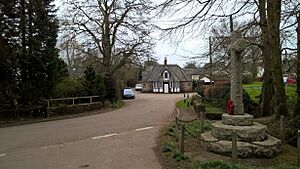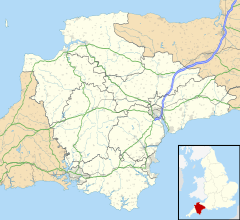Huntsham facts for kids
Quick facts for kids Huntsham |
|
|---|---|
 The war memorial and old post office in the centre of the village |
|
| Population | 138 (2001 UK Census) |
| OS grid reference | ST0047220446 |
| District | |
| Shire county | |
| Region | |
| Country | England |
| Sovereign state | United Kingdom |
| Post town | TIVERTON |
| Postcode district | EX16 |
| Dialling code | 01398 |
| Police | Devon and Cornwall |
| Fire | Devon and Somerset |
| Ambulance | South Western |
| EU Parliament | South West England |
| UK Parliament |
|
Huntsham is a small village in Devon, England. It is located in the Mid Devon area. The closest town is Tiverton, which is about 5.8 miles (9.3 km) to the south-west.
The village is surrounded by other areas like Bampton and Hockworthy. The River Lowman forms one of its borders. The highest point in the area is about 914 feet (279 meters) high.
In 2001, only 138 people lived in Huntsham. This was a decrease from 222 people in 1901.
Huntsham has a church called All Saints. It was fixed up by an architect named Benjamin Ferrey. Near the church is Huntsham Court, a large house. Ferrey also built this house between 1868 and 1870. It is now a very important historic building. Many of the village buildings were built around 1900 to support the big house.
Contents
History of Huntsham
An old Iron Age fort called Huntsham Castle is located on the southern edge of the village. This shows that people lived here a very long time ago!
Huntsham in the Domesday Book
The Domesday Book is a famous record from 1086. It shows that before 1066, a Saxon priest named Alric owned Huntsham. After the Norman Conquest, a person named Odo Son of Gamelin owned it.
Families Who Owned Huntsham
Over the years, different families owned Huntsham. The de Stanton family owned it around 1242. Later, in 1307, Peter de Dunsland was the owner.
In 1309, the Bere family took over. They owned the manor for a long time. One famous member was Thomas Bere. He was a Member of Parliament (MP) for Tiverton twice. An MP is a person elected to represent an area in the country's government.
The Bere family later moved to a nearby place called Morebath. Huntsham was then bought by the Lucas family, and after them, the Troyte family. William Troyte owned it in 1801, and Thomas Troyte in 1810.
Changes to Huntsham Court
When Thomas Troyte died in 1812, his younger brother, Edward Berkeley Troyte, inherited the manor. He was more interested in sports like fox hunting than looking after his properties. Because of this, the old manor house and the church were in bad shape when he died.
Edward left his estates to Arthur Henry Dyke Acland. Arthur then changed his name to Arthur Henry Dyke Acland Troyte. In 1854, Arthur hired Benjamin Ferrey to fix up the parish church.
When Arthur died in 1857, his oldest son, Charles Arthur Williams Troyte, took over. After he got married in 1864, Charles tore down the old manor house. He then built the beautiful Huntsham Court that we see today. It was designed by Benjamin Ferrey.
After Charles died, the manor passed to his sons. His third son, Sir Gilbert Acland-Troyte, owned it for a long time. He had no children, so when he died, the estate went to his nephew, John Acland-Troyte. John also died without children, and that was the end of the family's connection to Huntsham.



